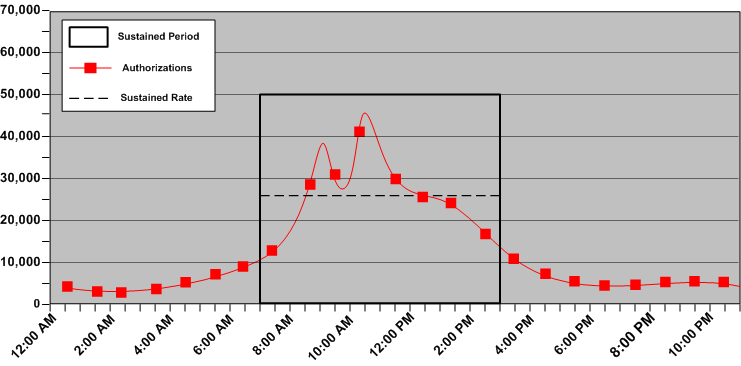

Estimating the sustained authorization rate for the application is the process of determining:
Complete the following steps to estimate the peak authorization rate for an application:
What is the estimated number of daily authorizations for the application?
The number of total logins (authentication load) and the number of page "hits" each authenticated user makes directly affects the number of daily authorizations (authorization load). A web page "hit" usually requires an authorization. Therefore, think of the authorization load of an application as total authorizations per day.
Note: When estimating the authorization load, we recommend that you begin with an evaluation interval of 24 hours. However, depending on the requirements of your enterprise, you can compare your daily results over a period of weeks or months to gain a better understanding usage throughout the year.
All users requesting the same number of pages per login is unlikely, so calculating total authorizations begins with determining the percentage of logins that generate one page hit, which the following represents:
authentication_load * percentage_of_authenticated_users * page_visits = daily_authorizations
Represents the estimated number of daily authentications for the application.
Represents the percentage of authenticated users that visit the same number of pages after login.
Represents the number of pages a particular set of authenticated users visits after login.
Note: A page can result in multiple GET/POST because it contains multiple objects. The total number of authorizations per page is the number of GET requests, plus the number of POST requests, minus the number of extensions the Web Agent ignores. For the purpose of this guide, each of the following examples assume that a page visit generates one GET/POST. For more information about configuring a Web Agent to allow access to specific resources types without checking policies, see the Web Agent Configuration Guide.
Represents the number of authorizations a particular set of authenticated users require.
Example 1: Estimate Daily Authorizations
As detailed in Estimate Daily Authentications, the portal application has an authentication load of 88,000 logins. Twenty-five percent of which visit one page after login:
88,000 * 0.25 * 1 = 22,000 authorizations
However, some logins generating more than one page hit is more likely.
Example 2: Estimate Daily Authorizations
The portal application has an authentication load of 88,000 logins:
88,000 * 0.5 * 10 = 440,000 authorizations
88,000 * 0.25 * 15 = 330,000 authorizations
The total authorizations per day (authorization load) is the sum of each of the authorization calculations.
Example 3: Estimate Daily Authorizations
The portal application has an authentication load of 88,000 logins:
Note: The percentage of authenticated users must equal 100 percent because each authenticated user generates at least one page hit.
Therefore, the authorization load for the portal application is 792,000.
The following table illustrates each of the previous examples:
|
Page Hits |
Percent of Total Logins |
Authentication Load |
Authorizations |
|---|---|---|---|
|
1 |
25 |
88,000 |
22,000 |
|
10 |
50 |
88,000 |
440,000 |
|
15 |
25 |
88,000 |
330,000 |
|
Authorization Load |
792,000 |
||
The company uses the authorization load to estimate the sustained authorization rate.
What is the sustained authorization rate for the application?
The sustained authorization rate is based on the authorization load, specifically, when and at what rate the authorizations occur. The chance that the authorization load is uniformly spread across your business day is unlikely. Rather, the rate at which requests occur fluctuates, remaining between the lowest and highest (peak) levels for a sustained period. Estimating the sustained authorization rate is the process of identifying a sustained period during which the system is servicing an average amount of authorization requests.
When estimating a sustained authorization rate, we recommend that you use the daily authorization load to determine:
Note: We recommend beginning with an evaluation period of 24 hours, broken down into one-hour increments. However, depending on the requirements of your enterprise, you can compare your daily results over a period of weeks or months to gain a better understanding of usage throughout the year.
The following figure is an example of these metrics:

Identifying these metrics helps you to estimate the number of authorization requests, per second, that CA SiteMinder® must service to maintain the average rate at which authorization requests occur, which the following represents:
(authorization_load * percentage_of_authorization_requests) / number_sustained_hours / 3600 = sustained_authorization_rate
Represents the number of daily authorizations for the application.
Represents the percentage of authorization requests that occur when the system is operating at sustained levels.
Example: If the authorization load is 500,000 requests, and 320,000 requests occur during the sustained period, then the value is 64 percent (0.64)
Represents the number of hours in which the system is operating at the sustained level.
Note: 3,600 represents the number of seconds in an hour.
Represents the number of authorization requests, per second, that CA SiteMinder® must service during the period of sustained activity.
Example: Estimate a Sustained Authorization Rate
As detailed in Estimate Daily Authorizations, the portal application has an authorization load of 792,000. The application portal is available to customers 24 hours a day, seven days a week. Using system activity reports to break down a typical day results in the following metrics:
(762,000 * 0.47) / 5 / 3600 = 19.90 authorizations per second
The portal application has a sustained authorization rate of 19.90 authorizations per second.
|
Copyright © 2015 CA Technologies.
All rights reserved.
|
|